Cite this document
(Architectural Competitions in Finland Case Study, n.d.)
Architectural Competitions in Finland Case Study. https://studentshare.org/architecture/1713568-architectural-competitions-in-finland
Architectural Competitions in Finland Case Study. https://studentshare.org/architecture/1713568-architectural-competitions-in-finland
(Architectural Competitions in Finland Case Study)
Architectural Competitions in Finland Case Study. https://studentshare.org/architecture/1713568-architectural-competitions-in-finland.
Architectural Competitions in Finland Case Study. https://studentshare.org/architecture/1713568-architectural-competitions-in-finland.
“Architectural Competitions in Finland Case Study”. https://studentshare.org/architecture/1713568-architectural-competitions-in-finland.


